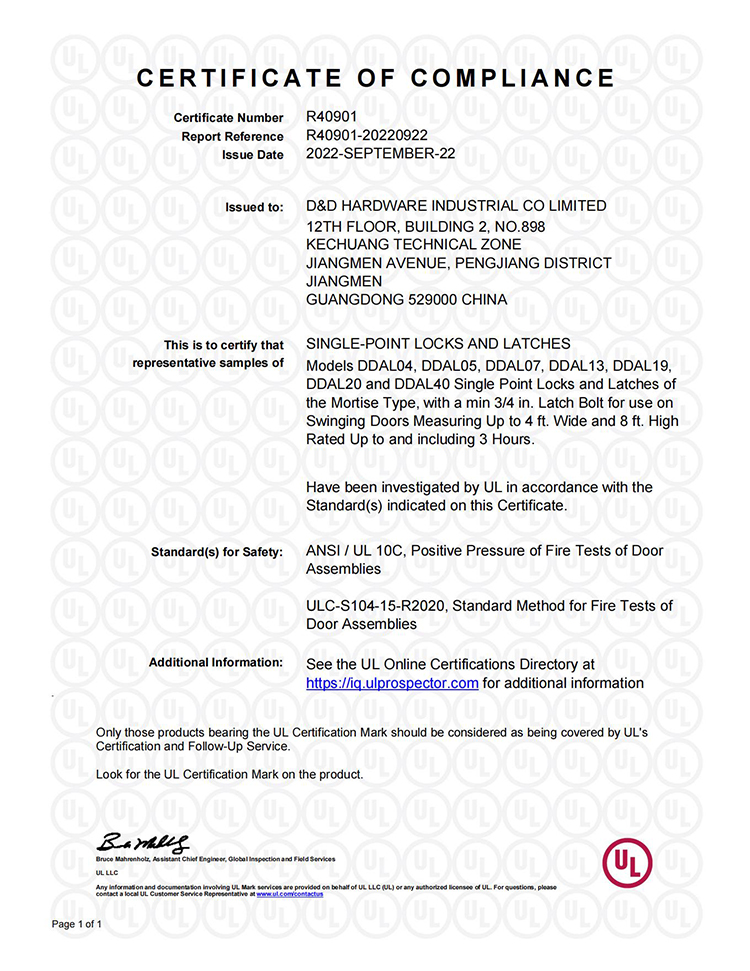Views: 0 Author: Site Editor Publish Time: 2024-01-31 Origin: Site

When it comes to ensuring safety in buildings, particularly in the event of a fire, the choice of locks on fire doors is a critical consideration. A fire door is an essential part of a building's passive fire protection system, and the type of lock used can significantly impact both the door's effectiveness and the safety of the building's occupants. In this article, we will explore the various aspects of selecting the right lock for your fire doors, balancing security and fire safety, and fireproofing existing locks.
Selecting the appropriate fire door lock is crucial for ensuring the safety and compliance of a building. Fire door locks are designed to withstand high temperatures and prevent the spread of fire and smoke, while also allowing for safe and timely evacuation. When choosing a lock for a fire door, it is essential to consider factors such as the type of building, the location of the door, and the level of security required.
There are several types of locks suitable for fire doors, including mortice locks, panic bars, and electromagnetic locks. Mortice locks are a popular choice for fire doors due to their durability and reliability. These locks are embedded into the door, providing a high level of security while maintaining the door's fire-resistant properties. Panic bars, also known as crash bars, are commonly used in commercial and public buildings. They allow for easy egress in an emergency while keeping the door securely locked from the outside. Electromagnetic locks, which are activated by an electrical current, are often used in conjunction with access control systems. They provide a high level of security and can be easily integrated into a building's fire alarm system to release automatically in the event of a fire.
It is important to ensure that the chosen lock is compatible with the fire door's rating and meets the relevant building safety codes. The lock should also be tested and certified to withstand the specific temperatures and conditions expected during a fire.
When considering locks for fire doors, building managers and owners often face the dilemma of balancing security with fire safety. While security is a paramount concern, it should not compromise the door's ability to function as a life-saving fire barrier. A fire door lock must allow for quick and unobstructed egress in the event of a fire, while also preventing unauthorized access.
To strike this balance, it is recommended to use locks that have been specifically designed and tested for use on fire doors. These locks should comply with fire testing standards, ensuring that they can maintain their integrity and functionality during a fire. Additionally, the integration of fire and security systems can enhance both security and fire safety. For example, an access control system linked to a building's fire alarm can automatically unlock fire doors during an emergency, facilitating evacuation while maintaining security under normal circumstances.

In some cases, it may be necessary to fireproof existing locks on fire doors. This can be a cost-effective solution for buildings with existing doors that need to be upgraded to meet fire safety standards. Fireproofing a lock involves ensuring that it can withstand the extreme temperatures of a fire without losing its structural integrity or functionality.
One method of fireproofing existing locks is to use intumescent materials. These materials expand when exposed to high temperatures, filling gaps and providing insulation that protects the lock mechanism. Intumescent kits are available for different types of locks and can be easily installed to enhance the fire resistance of existing locks.
Another consideration is the maintenance and regular testing of fire door locks. It is essential to conduct periodic inspections and tests to ensure that the locks function correctly and meet the required fire safety standards. This includes checking for signs of wear and tear, testing the lock mechanism, and ensuring that the door closes properly and securely.

In conclusion, choosing the right lock for a fire door is a critical aspect of building safety. It requires careful consideration of factors such as the type of lock, the door's location, and the balance between security and fire safety. Whether you are selecting a new lock for a fire door or fireproofing an existing one, it is crucial to ensure that the lock meets the necessary fire testing standards and building safety codes. By prioritizing both security and fire safety, you can ensure that your building's fire doors effectively protect occupants and property in the event of a fire.
Remember, the safety of a building's occupants should always be the top priority. By making informed decisions about fire door locks, you can significantly enhance the overall fire safety and security of your building.
Contact us Now:
Contact: David Jian
Mob:0086-139 2903 7292
Email: David@dndhardware.com, sales@dndhardware.com,
Jobby Zhang
Mob:0086-137 2599 9617
Email: jobby@dndhardware.com